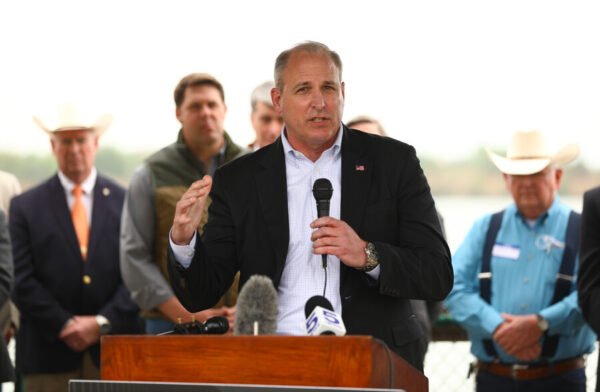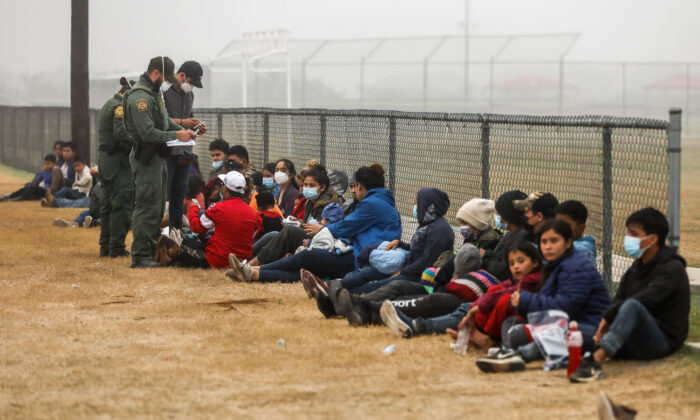Adults bringing unrelated children across the United States border illegally to facilitate a quick release became a huge problem in 2019 during the last border surge.
Border Patrol identified 5,800 fake families during an eight-week period covering the height of the 2019 crisis, according to congressional testimony from then-Acting Customs and Border Protection Commissioner Mark Morgan. Stories were rife of smugglers renting children to adults, and adults buying or borrowing children from parents.
This year, official data suggest that the problem has largely vanished.
Border Patrol agents have identified almost 70 cases of fraudulent family claims during the first eight months of this fiscal year—less than 2 percent of the number of 2019 cases, Customs and Border Protection (CBP) told The Epoch Times.
During the same eight-month period, agents apprehended 189,185 individuals within a family unit crossing the U.S.–Mexico border illegally, according to CBP statistics.
A Border Patrol agent who works in one of the busiest sectors along the border told The Epoch Times: “I can tell you that 70 [cases]—we probably get that easily in a few days.”
The agent, Carlos (not his real name), spoke to The Epoch Times on condition of anonymity, for fear of repercussions.
Carlos said the border facilities have often been so overwhelmed that the agents don’t have time to investigate possible fraudulent families, or they’re told not to pursue it.
He said that if an agent suspects a fraudulent family, the agent might be told by a supervisor, “No, we need to move the bodies out of here. Let it go.”
“And that’s how it’ll go. It’s not really pursued,” he said.
A CBP spokesperson said the agency relies on border agents to observe potential fake families and then conduct a further review, as well as check identification against data systems and sometimes with consular offices.
“CBP also conducts interviews to identify adults who fraudulently are claiming to be the parent of a minor child,” the spokesperson told The Epoch Times via email.
“CBP may also look for evidence that the same child has been encountered on multiple occasions with different adults or claimed family members.”
The agency refers suspected fraudulent families to ICE Homeland Security Investigations for further investigation and prosecution, the spokesperson said.
The rapid DNA testing used in 2019 to help ferret out fake families isn’t currently being utilized along the border. By law, children under 14 years old aren’t fingerprinted, and a photo is only taken if they’re part of a family unit.
In 2019, around 400 Homeland Security Investigations agents were sent to El Paso and the Rio Grande Valley in Texas to clamp down on the fake family phenomenon.
Those resources aren’t down at the border now, Morgan said.
“So unless they do what we did in 2019 and flood the southwest border with more ICE agents to conduct more investigations, I think you’re going to have a lot of fake families go undetected,” he told The Epoch Times on July 13.

Upcoming Changes
Morgan predicts that once the Title 42 public health emergency restrictions are lifted, which are still being used in some border areas to turn back some families, the number of unaccompanied minors will decrease and the number of families will increase even further.
The Biden administration dropped the Title 42 requirement for unaccompanied minors in February and immediately the numbers spiked, with subsequent months hitting record numbers.
“So we still have families that are coming up to the border, sending their kid across first [as an unaccompanied minor], and then they’re going as a single adult—because their chances of getting across now are high,” Morgan said.
Family units with children under 7 years of age are also exempt from the Title 42 restrictions and are quickly released into the United States with a court date or a notice to report to a local ICE office.
Carlos said he’s noticing a recent uptick in women bringing three to five children across the border.
“The amount of kids that the individual female is bringing across is through the roof. I’ve never seen it,” he said.
“Before, everyone came with one kid. Now, the family units that I’m seeing are ridiculous. One lady with four kids, one lady with five kids.”
Carlos said there’s “no doubt” women are bringing children over for other parents who are already in the country.
“One hundred percent—we see them every day,” he said. When they say they’re coming to the United States, they’re given extra kids to bring, and “here are the addresses to deliver them.”
Title 42 is in place until July 21, when the Biden administration will either renew or rescind it.
Border regions are bracing for a fresh influx as soon as it’s revoked, as all illegal crossers will need to be processed under Title 8, which is a much lengthier process and will require ICE for the detention and removal of single adults.

